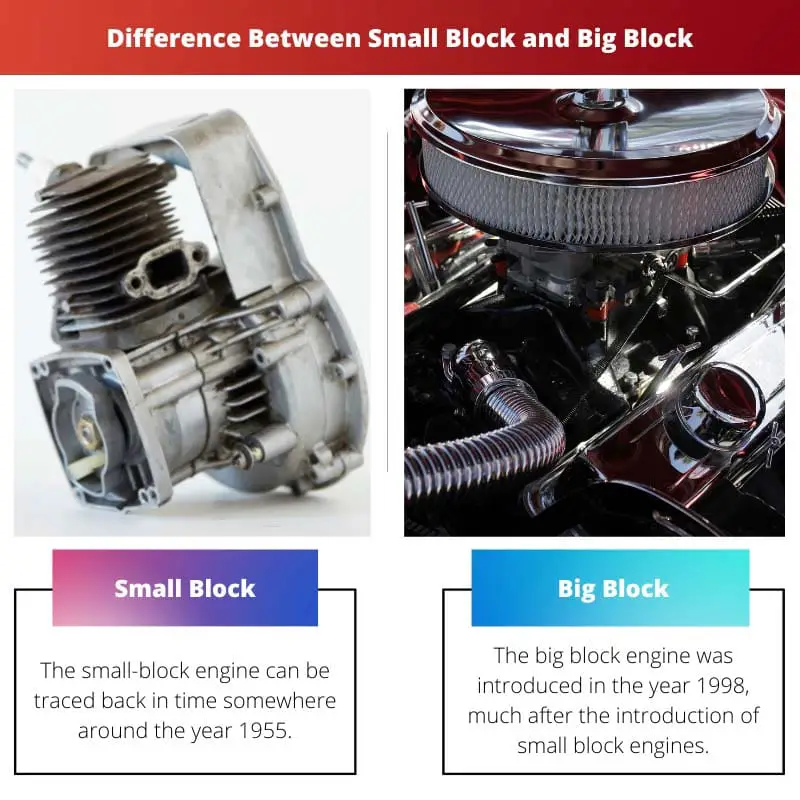In any kind of automobile, the engine happens to be the most prominent part, and without it, the complete machinery begins to fail.
In the most prominent types of engines, the two most common names are the small block and big block engines, and there are a number of differences that can easily be listed down between these two types of engines.
Key Takeaways
- Small block engines have a smaller displacement than big block engines.
- Big block engines have more power and torque than small block engines.
- Small block engines are more fuel-efficient than big block engines.
Small Block vs Big Block
The difference between small block and big block engines is that in the former, the frame rate happens to be smaller. Also, the size happens to be less heavy. But on the other hand, the latter happens to be relatively heavier and entails a bigger frame as compared to the previous one.

The small-block engine can be traced back in time somewhere around the year 1955, and this kind of engine is prominently used in sports cars, especially because of certain inbuilt characteristics and facilities provided.
This kind of engine consumes comparatively less fuel and gifts a very fast speed to the vehicle.
But on the other hand, the big block engine was introduced in the year 1998, much after the introduction of small block engines, and these engines were specifically used in vehicles that used to be of very big size, such as heavy trucks and other vehicles.
It helps the bigger vehicles to function and consumes a lot of fuel.
Comparison Table
| Parameters of Comparison | Small Block | Big Block |
|---|---|---|
| Introduced in | This engine was introduced in the year 1995. | This engine was introduced in the year 1998. |
| Size | The size of this engine is very small. | The size of this engine is very big and heavy. |
| Engine capacity | The maximum capacity is 6 liters. | The maximum capacity is 9 liters. |
| Suitable for | Most suitable for light-weighted cars | This engine is most suitable for vehicles that are heavy and require more power for being operated. |
| Fuel consumption | It consumes a very less amount of fuel to run. | It consumes a lot of fuel comparatively. |
What is Small Block?
In the year 1995, a particular need to manufacture specific engines for sports cars and other light-weighted vehicles was felt, and this particular need gave birth to the emergence of a certain specific kind of engine known as the small block engine.
Initially, this engine used to come up in a 4.1-liter variant, but with the passing of time, certain other variants were also introduced by the companies.
In today’s time, approximately 6.6 liters is the limit of these small block engines, and they can sufficiently provide enough power for a light vehicle.
This kind of engine is prominently popular across many users due to different reasons belonging to different kinds of people.
For some users, this engine happens to be the most suitable as it saves a lot of fuel in the long run, but for some users, this engine can be of their type because of the fact that it makes the vehicle run at a very fast pace.
However, in size, as the name itself suggests, this engine happens to be a lot smaller as compared to the big block engine, and the displacement happens to be small as well.

What is Big Block?
Soon after the introduction of small block engines in the consumer market, the manufacturing companies felt that they needed to produce a separate engine for vehicles that are very heavy weighted and require a different kind of strength in their engines.
Owing to this particular demand, the big-block engines were subsequently introduced in the year 1998 for the very first time, and they appeal to the interest of many users having many heavy vehicles such as trucks and other vehicles.
The reason behind these engines being called the big-block engine is to signify that these engines are only suitable for vehicles of very big size and not for vehicles of very small size.
This particular demonstration excludes this engine from the race of small vehicle engines. Initially, it was launched in a variety of 5.7-liter but keeping in mind that demand caused the size of the newly manufactured heavy vehicles.
The variant has now shifted to 9.1-liter. However, one disadvantage attached to this particular kind of engine is that it consumes a lot more fuel as compared to the small block engines.

Main Differences Between Small Block and Big Block
- The small-block engine was first launched in the year 1995 while on the other hand, the big block engine was first launched in the year 1998.
- A small block engine is more suitable for light-weighted cars, while on the other hand, the big-block engine is more suitable for heavily weighted cars.
- Small block engine has a minimum variant to a limit of 4.1 liters, while on the other hand, the big-block engine has a minimum variant of 5.7-liter.
- The small-block engine has a maximum variant of 6 liters, while on the other hand, the big-block engine has a maximum variant of 9 liters.
- A small block engine saves a lot of fuel as compared to other engines, while on the other hand, the big-block engine consumes a lot of fuel.

References
- https://www.sae.org/publications/technical-papers/content/2013-01-1732/
- https://books.google.com/books?hl=en&lr=&id=eT7LT69STO0C&oi=fnd&pg=PA7&dq=big+block+engine&ots=4GwgktUIaf&sig=q7pwnq8Bfzp5ZNtGKxK8Nr5NDbc
